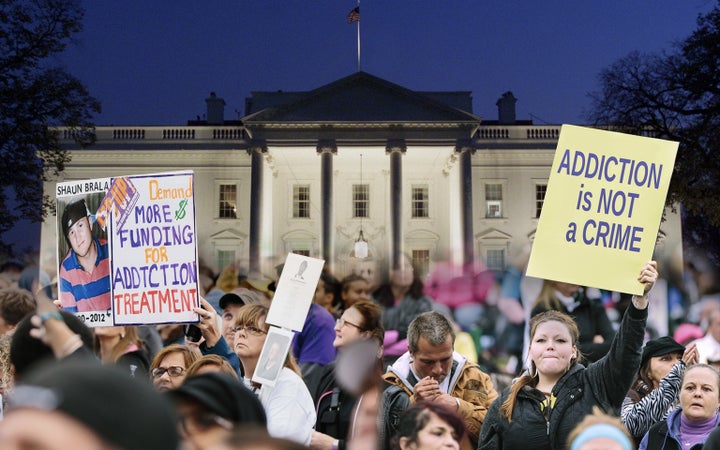
On Thursday, the three major television networks suspended their daytime programming to broadcast the testimony of former FBI Director James Comey. This extraordinary step showed that nothing else was more important, even advertising revenue. It’s safe to say that we are somewhat distracted as a country right now. You can feel the hysteria in the air. The tension is crackling, like static electricity.
But no matter what happens in Washington or how bizarre our national reality may be right now, the greatest health crisis of our time continues to unfold and proliferate. Breaking news may suspend talk shows and soap operas but it has no effect on a drug craving. It can’t keep someone breathing as they gasp their last breath in an overdose. The collateral damage of the circus in Washington is that no real, meaningful progress has been made to develop a unified approach to deal with the addiction crisis—and the cost is lives lost.
If you want something done, you’ve got to do it yourself. It looks like we are on our own. That’s incredibly clear to those of us who are working to fight this public health crisis. Addiction policy is lagging while families, communities, grassroots organizers, and nonprofits are on the cutting edge of saving lives. In this case, change is bubbling from the bottom up, not the top down. But without leadership and cooperation from the White House, there’s only so much we can do.
People keep dying. Obituary columns are full with articles about wonderful young men and women who had “bright futures.” We are brokenhearted and tired. We’re also frustrated and fed up. It’s time for the government to look at what’s working in the grassroots and support the sweeping changes we need.
“If anything, the decisions being made by the current administration might reverse decades of work.”
As the crisis worsens, our families and communities are the ones bearing the burden of these monumental losses. Yet, we haven’t given up hope and we haven’t stopped pushing for change. If anything, the people who stand up most are actually working the hardest to stop this deadly drug epidemic. Families, churches, local law enforcement, grassroots organizers, philanthropists, and local leaders are the ones in the trenches. We experience the crisis first hand. We love and care for people with substance use disorder.
Yet, legislation is slow to follow in our footsteps. If anything, the decisions being made by the current administration might reverse decades of work and endanger the lives of people with substance use disorder. The Comprehensive Addiction and Recovery Act was signed into law by President Obama almost a year ago, but Congress has yet to allocate funding for its provisions and it lays there nascent—a mere pile of paper—as the dying persists.
The movement to help people with substance disorder isn’t a new one. It’s been around for a century or more, functioning under different names, since the Revolutionary War. An early temperance movement started in the 1770s, when farmers in Connecticut, New York, and Virginia formed associations to ban whiskey distilling. In the 1820s, these groups spread and became more radical, calling for total abstinence from alcohol. They called alcohol a “scourge” and distributed pamphlets that showed families torn apart by intoxication. The Oxford Groups, Alcoholics Anonymous, and other spiritual programs have carried the banner of these early movements.
Now, our society is more sophisticated. A century ago, all we had was prayer: now, medicine, psychology, and other treatment modalities have shown that they are also useful tools to fight addiction. Private clinics and hospitals have often spearheaded experimental treatment for people who were considered “doomed” and untreatable. Today, we incorporate those methods into standard treatment for substance use disorder. They have become the “norm,” because people on the front lines pushed hard to make this kind of help available. We’re still doing this work today, through action networks, committees, and citizens’ groups.
And that work must be done: there is no time to waste.
Plenty of nonprofits have thrown their weight behind the growing recovery movement. 10,000 Beds, in Utah, aims to award 10,000 recovery scholarships by 2020, ensuring that people in need can access treatment and care. The McShin Foundation, Virginia’s leading Peer to Peer Recovery Community Organization, helps connect people in recovery with housing, employment, education, and a network of like-minded people. And nonprofits aren’t just focused on adults, either. Oregon Recovery High School Initiative is building a high school exclusively for young people affected by substance use disorder, and will offer recovery support services in addition to academics. These groups, along with over 600 others, are part of the action network at Facing Addiction, one of America’s leading non-profits dedicated to ending the addiction crisis. Their innovations would have been unthinkable a century ago: yet these groups are on the cutting edge of the recovery movement.
So, where’s the government in all of this? From the White House’s lack of action on the opioid epidemic, to denying Medicare to people with substance use disorder, to defunding social services that benefit people who are on their way to recovery, this administration has made it clear that recovery is not a priority. The Office of National Drug Control Policy is expected to have its budget drastically cut, and still no director has been appointed. People with substance use disorder need treatment, not jail time. Peer recovery support, not homelessness.
The grassroots recovery movement is innovative, responsive, and progressive – and it often cuts across party lines. By keeping the focus on our mission, we’ve been able to accomplish a lot. There is still much more to do. The death toll continues to rise. And yet, the opioid epidemic is not acknowledged as what it is: the largest public health crisis we face today. It’s claimed more American lives in this year alone than the entire Vietnam war.
Lobbyists and advocates have accomplished so much over the last decade in destigmatizing substance use disorder, finding a place at the bargaining table, and focusing on health care and human rights. While nonprofits, families, and communities fill in the massive gaps left by inhumane public policy, we must keep calling on legislators to catch up.
We’re light years ahead. And yet, for some people and their families, we’re already too late.
Ryan Hampton is an outreach lead and recovery advocate at Facing Addiction, a leading nonprofit dedicated to ending the addiction crisis in the United States.
